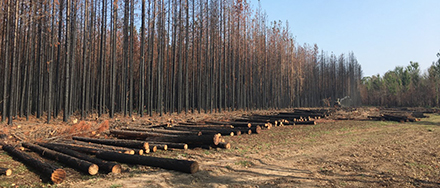
The Northern NSW forestry industry has begun salvaging burnt timber from softwood plantations impacted by recent fires, with local production to increase fourfold over the next year. Forestry Corporation NSW Grafton District Manager Trent Froud said plantation timber harvesting would take place at four times the normal annual rate to ensure burnt trees were salvaged while the timber was still good. Source: Timberbiz
“This season’s fires have had a significant impact on the local softwood timber industry, burning more than 60 per cent of the pine plantations in the Grafton district and destroying the sawmill of our major customer at Rappville,” Mr Froud said.
“However, while a large area has been burnt it is by no means lost. With the intensity of these fires some of the southern pine trees we grow in the plantations around Grafton will die, but if we get to them quickly the wood is still good.”
Experience from past fires had shown that the Southern Pines grown in northern NSW were quite fire resilient.
“So, we’re hopeful a proportion of the burnt plantations will survive,” Mr Froud said.
“At this early stage the wood underneath the burnt bark has exactly the same structural properties as unburnt timber, so it can be harvested and processed into house frames, furniture and other essential renewable wood products.”
Mr Froud said that there was only a 12-month window to salvage the burnt timber before it started to deteriorate.
“So, we will be working at about four times the normal rate to get this timber while it’s still good,” he said.
“We have already brought on new contractors and customers and have started the enormous task of harvesting the burnt timber.
“There is a significant task ahead of us, creating a lot of local work to process this timber and re-establish State forest timber plantations for generations to come.
“Forestry is a long term-industry and we are already looking 20 or 30 years ahead into the future to maintain supply of essential timber products.”





